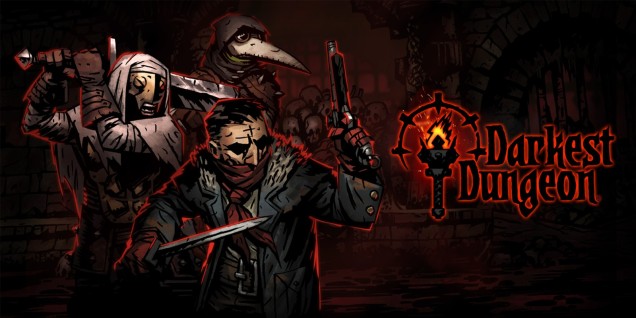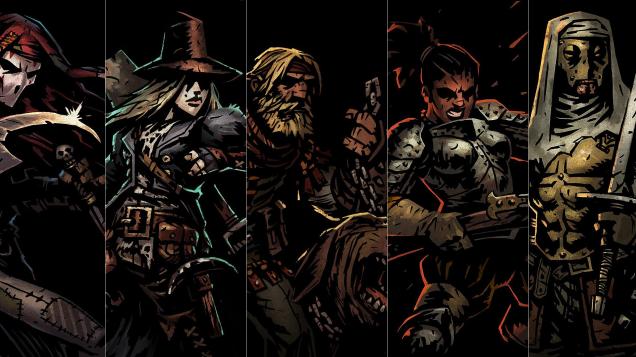Darkest Dungeon is one of the most original and innovative dark RPGs ever. The addictive gameplay, the incredible art-style and the horror elements, created the perfect formula for a game that defined a new genre. As the name suggests, this is a really dark RPG, with strong horror components rooted in an unforgiving and complex system. Permanent death, mental and physical diseases, balance of light and darkness, Darkest Dungeon really knows how to perfectly integrate horror elements into a modern RPG. Worth also to specify that the world of Darkest Dungeon is one of the most original dark fantasy settings, from every abomination lurking in the darkness to the original classes.
With the recent announcement of Darkest Dungeon 2, the series is back to bring horror and despair upon the players. I had the opportunity to chat with Chris Bourassa, co-founder of Red Hook Studios and creative director of Darkest Dungeon. With more than 14 years of experience as art director and concept artist for several videogames, series and also pen-and-paper games, Chris is not only co-creator of Darkest Dungeon, but also the main artist behind the distinctive art-style of the game.
His answers provide information on how Darkest Dungeon was born, about his art-style, and also some details about a very interesting unreleased creature (which I really hope to see in the sequel). If you are like me, craving for news regarding the sequel, the following interview is the perfect reason to dig even more in the lore and the secrets of Darkest Dungeon.
Q1: I would like to thank you for the opportunity of interacting with you. Darkest Dungeon (DD) became in the last year a new reference for dark RPGs, with many games inspired by its art-style and mechanics. How the idea of Darkest Dungeon was born?
A1: Darkest Dungeon began as a series of loose sketches I would chip away at on my bus rides. It struck me that that power in games is represented primarily through more and more elaborate gear. However, in reality, it’s the willingness to fight, rather than the rarity of the sword that is the mark of a hero. Tyler Sigman and I sought to explore a more subversive take on the traditional RPG tropes – one that embraced the idea that heroes are human – have flaws, weaknesses, and shortcomings.

Q2: The gorgeous art-style of DD is also something that contributed to the mainstream success of the game, something really unique that now defines a new style by itself (often you can read around “Darkest Dungeon style”). Why did you decide to use this particular art-style to portray the world of DD? Which are the main influences in your style?
A2: I had spent many years working in a variety of styles, generally more painterly. However, I decided Darkest Dungeon needed a look that would reinforce its central themes. Hard edges reflect the uncompromising choices a player is faced with, and the pooling black suggest ever encroaching disaster. I looked at a lot of illuminated manuscripts, medieval woodcuts, and modern comics including Mike Mignola’s Hellboy and Guy Davis’ The Marquis. The latter being my favourite graphic novel of all time! All of these ideas and influences helped me craft a style that was morbid, but iconic. I like to think that despite the subject matter, there’s still some ‘fun’ injected into the work.
Q3: There are many interesting references inside DD, but personally I love how you integrated in an original and personal way concepts from Lovecraft in the world of DD. Why did you choose Lovecraft’s myths as one of the main references for DD? Was there something “Lovecraftian”, such a tale or a setting, that you truly wanted to introduce, but at the end you were not able to?
A3: What appealed to us most was cosmic horror. We didn’t want to make a Lovecraftian game, we wanted to make our own dark corner of the earth, and work with Lovecraftian themes like the cosmic insignificance of man. I will confess that the story ‘Rats in the Walls’ was a touchstone for the narrative set up of the game, but we consciously avoided established nomenclature and specific creatures/references from Lovecraft. By this time, all the DLC has come out, and I can’t say that we left much on the cutting room floor!

Q4: DD implements several mechanics maybe more common in horror games, from sanity, to light/darkness management and permanent death. Why did you implement these features into DD? How these mechanics are integrated into the world you created?
A4: It was important that our game feel like high stakes poker – the player is playing with her best characters, each of whom represent a certain amount of time investment. Permadeath in this context helps increase the tension and player engagement. Other mechanics, light torchlight help sell the feeling of dread and pressure – crucial to creating a good horror experience.
Q5: Fantasy RPGs are often quite standardized and can be easily full of stereotypes, especially regarding the heroes/classes. However, when the majority of the games have the Mage and the Paladin, Darkest Dungeon was really able to create unique and interesting classes, such as the Plague Doctor, the Grave Robber or the Hound Master. How did you came up with the idea to go far from the standard fantasy stereotypes?
A5: Establish tropes carry a lot of expectation with them from audiences – that’s part of their appeal. However, it can create dissonance when those expectations aren’t met. We explicitly decided to avoid standard RPG nomenclature and character classes wherever possible – the tropes themselves can really box in creative thinking. If I tell you we have a Rogue in our game, but that the Rogue can’t turn invisible, doesn’t backstab, and has a pistol instead of dual daggers, your response would probably be “…that’s not a great Rogue.” But, if I tell you it’s a Highwayman, suddenly, as a creator, I’m free to dictate what makes this character cool, unconstrained by your expectations. Additionally, the sense of discovery a player experiences as they learn about these new character classes is an engaging and refreshing journey!

Q6: Still regarding the heroes/classes, which is your favourite hero and why?
A6: I like them all 🙂
I think I identify most with the Highwayman – something about the practical jack-of-all-trades brawler appeals to me. I referenced The Shadow when coming up with his design, and I like the mystery that the bandanna brings. That said, the Leper and Plague Doc were milestones for us in terms of how we thought about our classes.
Q7: DD was one of the finest example of a good use of the Early Access (EA). For the fans that didn’t follow the game since EA, what was the mechanic that changed the most from EA to the final release?
A7: Enemy corpses and skill/trinket balance are the things that changed most throughout our stint in Early Access. Obviously, we added a ton of content as well, but as far as gameplay-oriented changes, those were the big ones.
Q8: DD is famous to be a challenging and unforgiving game, with a deep system difficult to master. Did you have some challenges yourself while testing the game?
A8: The biggest challenge we faced was getting the actual game finished! Our team was small, and everyone worked extremely hard. There were periods of elation, periods of despair. We had children born, and loved ones pass away. It was an intense, exhausting, and profoundly rewarding time in our lives. We even began referring to our current state of mind in game terms, admitting when we were stressed, ‘afflicted’, or celebrating when someone over delivered by telling them they passed their stress-check!
Q9: DD is a unique game also for the design of the enemies. From the Collector to the Swine Prince, each boss battle is unique and interesting both for design and mechanics. How did you create these creatures and what inspired you the most during the process? Was there a creature you really wanted to introduce, but at the end was cut-out from the final release?
A9: The monsters and bosses were great fun to design and draw. Often times they were built ‘theme-first’ – that is, the Hag and her pot was such a great visual that we figured out how to make the mechanics work after the fact [Figure Below].
I had an idea for a schoolteacher whose classroom was full of desiccated corpses tied to their chairs. If you let him complete the lesson, he’d drive you mad. It was a cool idea. Actually now that I think about it, maybe we’ll put that in the sequel!

Final Remarks
I would really like to thank Chris for his courtesy and kindness. It was really interesting to discover the complex processes behind the developing of such important game, and I am sure that fans of dark RPGs will appreciate too. As many others, I am really looking forward to discover which new classes and terrible abominations will be available in Darkest Dungeon. While waiting for the sequel, I suggest to the readers to try Darkest Dungeon, which is available for Nintendo Switch, PlayStation 4, Microsoft Windows, Mac, Linux, iOS, PlayStation Vita, and Xbox One.